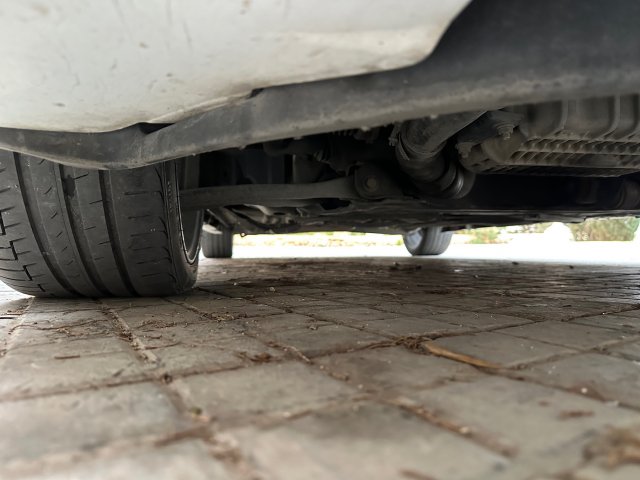I'm no motorsport expert either but I believe the control arm should be parallel with the ground. If you want to maintain your current ride height, removing the extended ball joint will probably fix the angle. OR you could lower the car another 20mm and that will probably get you to a more ideal control arm angle. I would personally lower the car. Extended ball joints are typically only used in cars lowered a pretty decent margin. With a mild drop I don't think it was necessary.
TL;DR - the OP has it right, and all the conventional wisdom (control arm horizontal and many other rules of thumb) come from tuning cars with proper double wishbone or multilink suspension, and not modern cost optimized cars with compromised strut suspension (which is used because cheaper, lighter and easier to package in tight spaces).
Long version:
It’s all about camber gain. From an abstract point of view, what you want is that as the car rolls that the suspension linkage on the outside leans inward relative to the chassis (negative dynamic camber), and the inside wheel leans outward.
This would effectively keep the equally abstract infinitely stiff tire vertical and in maximum contact with the road
Even a very stiff car will roll 2-3 degrees in a corner.
That’s the ideal. A car that does that in reality would have poor steering and road feel, and almost zero warning at the edge of grip before the tire lets go.
In the real car, there are other factors we also care about. We need additional camber gain for tire sidewall flex. But what’s also important is that while we still want camber gain in the suspension, what we actually want is slightly less gain than we have body roll. This helps the car to feel like it’s more progressively losing grip, which is good for being able to control the car at the edge and “feel” the point before the tire lets go.
For a double wishbone car, you want the lower parallel to the ground or slightly lower, as this is the point in the SLA (short-long arm) linkage where the camber gain is the maximum. This helps with turnin. Compressing the suspension above that point the car gains less camber per degree of roll, giving us that nice sports car feel of controllability.
But one of the many ways Macpherson struts suck is that they behave as if the upper control arm (replaced by the strut) has infinite length (does not change angle) this means have only the lower arm moving inward and outward causing camber gain, which isn’t very much (it’s never enough to compensate for body roll)
So we have a little camber gain as control arm starts below vertical (which pushes the bottom of the hub outward) and as soon as the control arm moves above horizontal, we actually start losing our camber gain as the lower control arm pulls the hub inward
This is slightly improved by tilting the strut inward (stock, out front strut is angled almost 4 degrees inward at stock ride height). Once we pass that 4 degree upward angle on the control arm, we actually start losing negative camber and going positive (aka the wheel starts leaning outward even more than the car body is rolling) which doesn’t just give progressive breakaway but actually starts reducing peak grip if you’re not careful
So with struts we have to compromise. Stock, the FiST control arms sit about 6 degrees below horizontal. Between -6 and +4, we get camber gain, just less than we wish we had. So we compensate with caster and more static negative camber than what’s needed for a double wishbone car. Starting below -6 would give more camber gain.
But too much control arm down angle causes an upward push on the body and suspension (jacking) which makes the car unstable, lifting the CG and like a jacked up truck, more prone to rollover.
The stopgap with struts is that we have to run even more static negative camber to compensate, and we stiffen up the sway bars more than we would for a car with proper suspension to prevent body roll from losing camber on the inside tire
Too much upward angle (lowered car) causes extra compression on the inside suspension, which at the extreme, creates excess body roll (making our camber situation even worse)
So with a strut car lowered to horizontal control arms you’ve given up all but the weakest 4 degrees of camber gain. You can kind of but not really compensate with even more negative camber, but that also hamstrings the inside wheels, which while they get partially unloaded in a turn, still contribute some to grip.
At 1” lowered (mildest lowering), we are looking at less than a degree below horizontal, which is already not so good.
Yet another reason (besides roll centers) why a better range is between stock, and at most 0.5”/(12mm) lower which still keeps the control arm between 4-6 degrees downward slope at static height


